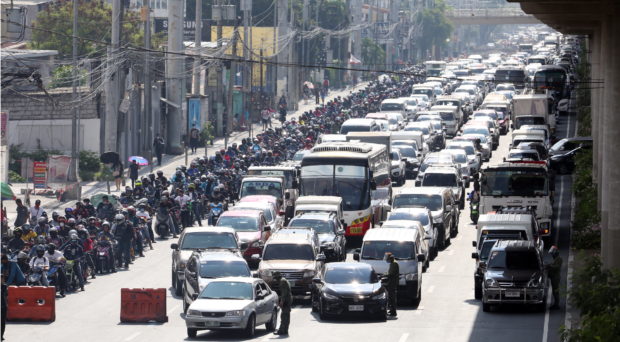
NO DISTANCING Heavy traffic returns on Marcos Highway, as police inspect motorists passing the road on the first day of work amid the implementation of the modified enhanced community quarantine. (Photo by NIÑO JESUS ORBETA / Philippine Daily Inquirer)
MANILA, Philippines — The government will place Metro Manila on lockdown anew if coronavirus cases keep on increasing as a result of the easing of quarantine restrictions, Malacañang said on Monday as the Department of Health (DOH) reminded residents of the metropolis that the fight against COVID-19 “is not yet over.”
Presidential spokesperson Harry Roque said the government eased the quarantine rules in Metro Manila on the assumption that the public would follow health measures to prevent a resurgence of the new coronavirus.
“We expect everybody’s full cooperation. If there’s no full cooperation, we will go back to [enhanced community quarantine] because the state cannot be remiss in its obligation to protect the health of its citizens,” Roque said.
Second wave of infections
“If we keep this up, all of us will receive not financial aid but COVID-19,” he added.
Roque was referring to the jostling at shopping malls on Saturday as hordes of people poured in, ignoring safety measures, after authorities began loosening a two-month lockdown. (See related story in Regions, Page A5.)
He warned that the Philippines could be hit by a second wave of infections like what happened to other countries that lifted quarantine restrictions but failed to control people’s movement.
Speaking at her daily press briefing, Health Undersecretary Maria Rosario Vergeire said the easing of quarantine restrictions in Metro Manila did not mean the threat of the new coronavirus was no longer there.
“We understand that the easing of [restrictions] helped reduce the mental stress brought about by the two-month lockdown. We are now hopeful that we could already go back to work, which will unburden us of the financial stress,” Vergeire said.
“But we remind everyone, the fight against COVID-19 is not yet over. This is only the start of the new chapter of our fight,” she said.
Restart the economy
Vergeire pointed out that the government allowed shopping malls to reopen not for the public to wander around but to restart the economy.
“This was done for the economy,” she said. “We should bear in mind that we have a huge responsibility to prevent community transmission [of the virus]. If more people go out and do not observe physical distancing and other preventive measures, there is a bigger possibility for the virus to spread.”
On Monday, the DOH reported 205 new coronavirus cases, pushing the national total to 12,718. The majority of the new cases, 145, were recorded in Metro Manila.
The total number of recovered patients increased to 2,729 with the recovery of 94 more patients. But the death toll rose to 831, as seven more patients died.
According to Roque, Metro Manila has only 13,457 beds for COVID-19 patients. Of these, he said, 9,468 are isolation beds, 1,303 are intensive-care beds, and 2,686 are ward beds.
The government, he said, has 1,963 ventilators for COVID-19 patients.
Roque said local governments had set up quarantines with 40,497 beds and the national government had converted several event venues into isolation centers with 2,908 beds.
“If the case doubling time reverts to two days, in a week or two we will run out of beds and you will have to be treated out in the streets because there are no more beds for the sick,” he said.
Warning
Roque told shopping mall operators and local officials to enforce physical distancing strictly or the government would shut the malls again.
“To malls which do not observe social distancing and crowd control, it’s quite easy—we will just shut you down again,” he said.
He said shopping mall owners may also face criminal liability if they failed to implement quarantine measures.
Roque maintained that the government’s decision to loosen quarantine restrictions was not a mistake and that the state did not ignore the advice of health and statistics experts.
“It’s not a mistake because after two months, we need to open up our economy a little,” he said.
“We need to resume our livelihoods,” he said, but added: “It’s no reason to go malling.”
Vergeire reminded local officials and shopping mall administrators to be stricter in enforcing minimum public health standards.
Testing workers not required
She reiterated the government’s policy that workers were not required to be tested for the coronavirus for them to be allowed to return to work.
But several senators were worried that the policy could lead to a fresh surge of infections.
Sen. Joel Villanueva, chair of the Senate labor committee, said a representative sample of workers should be tested regularly to see if the coronavirus was spreading.
Sen. Risa Hontiveros said workers must be tested, and employers and the DOH must arrange for the tests.
Speaking in a radio interview, Sen. Sherwin Gatchalian said it would be best if employers would shoulder the cost of their employees tests if they could afford it.
Some business groups have been pushing for the rapid testing of employees before bringing them back to work, but Vergeire said the results from rapid antibody tests were not a sound basis for allowing workers to return to their jobs.
“The rapid antibody tests do not show if someone has COVID-19,” Vergeire said. “What it detects is the presence of antibodies, not the virus. It also cannot detect if you will have COVID-19 in the next few days. Even if you test negative today, you can still get infected because of your continued possible exposure [to the virus].”
—WITH REPORTS FROM JOVIC YEE AND LEILA B. SALAVERRIA